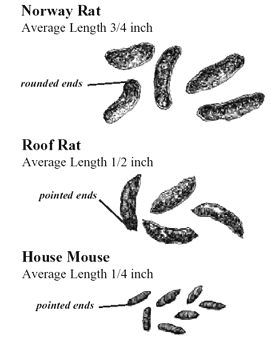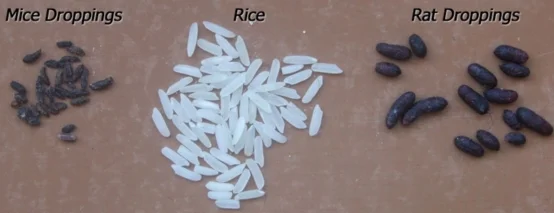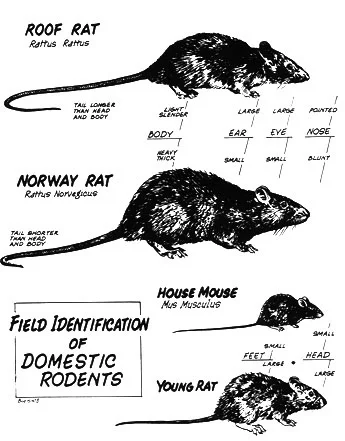Rat Poop , Mouse Poop , Squirrel Poop & Raccoon Poop Diseases
If you’re noticing rodent tracks or feces or evidence of rats in attic of your home, be it rat, mouse or really any types of rat or types of squirrels, it’s important that you seek a specialists who can better assess your homes’ health. We have provided you with the information here pertaining to the most common diseases transmitted by an animal in the attic or a Rodent Removal problem living in or near your living area.
We have also written a great article titled Rat vs Mouse , how to tell the difference between the two, incase your journey here has led you with those ideas.
So what kinda poop is this ?
Click here to see What does rat poop look like ?
Click here to see What does mouse poop look like ?
Click here to see What does squirrel poop look like ?
Click here to see What does raccoon poop look like ?
Click here to see What does opossum poop look like ?
Health issues caused by rodent feces :
The following 4 diseases are caused by rodent feces and are region-specific.:
Bubonic Plague:
The dreaded plague is less prevalent and deadly today, but still infects numerous people every year. This is normally spread through fleas on a rodent, but feces can also contain the plague. Symptoms include headache, fever and swollen lymph nodes.
Hantavirus:
Rodent urine and feces is the primary cause of the Hantavirus. Caused by the white-footed deer mouse, this virus is often seen when these mice are allowed to actively live in the same dwelling as their human counterparts. An infestation in an attic is a prime example of how the Hantavirus can be contracted, although humans don’t realize the mice are living in the home.
Lassa Fever:
A virus that is contracted through the breathing in of dust that is contaminated with feces or urine. This disease can also be contracted through touching the feces or bites and is spread by rats.
Rat-bite Fever:
Food that is contaminated by rodents can cause rat-bite fever. This is an infectious disease that can be fatal.
Salmonellosis:
Spread through rodent feces. Salmonellosis is a type of food poisoning that causes high fevers, abdominal pains and diarrhea.
These are just the viruses that are normally seen in Metroplex Area. There are also several other rodent-transmitted viruses that are less common in the area, such as Leptospirosis, Hemorrhagic-Fever and Tularemia. All of these diseases are classified as worldwide by the CDC.
Whatever the case, if you’re seeing rodent feces, droppings, or otherwise tracks of any sort, it’s best to let a rodent remover professional inspect the situation.
Diseases directly transmitted by rodents
Hantavirus Pulmonary Syndrome
Rodents involved with this disease mostly occur in North and South America
The disease spreads
Breathing in dust that is contaminated with rodent urine or droppings
Direct contact with rodents or their urine and droppings
Bite wounds, although this does not happen frequently
Additional Information
Hantavirus Pulmonary Syndrome (HPS)
Hemorrhagic Fever with Renal Syndrome
Rodents involved with this disease mostly occur in Asia, Russia, Korea, Scandinavia, western Europe, and the Balkans
How the disease spreads
Breathing in dust that is contaminated with rodent urine or droppings
Direct contact with rodents or their uring and droppings
Bite wounds, although this does not happen frequently
The disease may spread through direct contact from person to person, but it is extremely rare
Additional Information
Hemorrhagic Fever with Renal Syndrome
Lassa Fever
Rodents involved with this disease mostly occur in West Africa
How the disease spreads
Breathing in dust that is contaminated with rodent urine or droppings
Direct contact with rodents or their urine and droppings
Eating food that is contaminated with rodent urine or droppings
Bite wounds, although this does not happen frequently
The disease may spread through direct contact from person to person
Additional Information
Leptospirosis
Rodent(s) involved
Rodents and other animals
Rodents involved with this disease mostly occur in Worldwide
How the disease spreads
Eating food or drinking water contaminated with urine from infected animals
Contact through the skin or mucous membranes (such as inside the nose) with water or soil that is contaminated with the urine from infected animals
Additional Information
Lymphocytic Chorio-meningitis (LCM)
Rodent(s) involved
House mouse (Mus musculus)
Rodents involved with this disease mostly occur in Worldwide
How the disease spreads
Breathing in dust that is contaminated with rodent urine or droppings
Direct contact with rodents or their urine and droppings
Bite wounds, although this does not happen frequently
Additional Information
Omsk Hemorrhagic Fever
Rodents involved with this disease mostly occur in Western Siberia
How the disease spreads
Direct contact with infected animal
Bite from an infected tick
Additional Information
Plague
Rodent(s) involved
Wild rodents, including rock squirrels, prarie dogs, wood rats, fox squirrels and other species of ground squirrels and chipmunks
Rodents involved with this disease mostly occur in Western US, South America, Africa, Asia
How the disease spreads
Bite of an infected flea
Direct contact with infected animal
Additional Information
Rat-Bite Fever
Rodent(s) involved
Rats and possibly mice
Agent
Bacteria
Rodents involved with this disease mostly occur in Worldwide; Streptobacillus moniliformis in North America and Europe; Spirillum minue in Asia and Africa
How the disease spreads
Bite or scratch wound from an infected rodent, or contact with a dead rodent
Eating or drinking food or water that is contaminated by rat feces.
Additional Information
Salmonellosis
How the disease spreads
Eating or drinking food or water that is contaminated by rat feces
Additional Information
South American Arenaviruses (Argentine hemorrhagic fever, Bolivian hemorrhagic fever, Sabiá-associated hemorrhagic fever, Venezuelan hemorrhagic fever)
Rodents involved with this disease mostly occur in South America: parts of Argentina, Bolivia, Venezuela and Brazil
How the disease spreads
Breathing in dust that is contaminated with rodent urine or droppings
Direct contact with rodents or their urine and droppings
Bite wounds, although this does not happen frequently
The disease may rarely spread through direct contact from person to person
Additional Information
Tularemia
Rodents involved with this disease mostly occur in Worldwide
How the disease spreads
Handling infected animal carcasses
Being bitten by an infected tick, deerfly or other insect
Eating or drinking contaminated food or water
Breathing in the bacteria, F. tularensis
Additional Information







